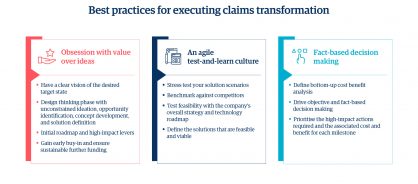- Blog
How execution strategy makes or breaks six examples of claims transformation

The question I'm asked most often by chief claims officers is, "I have my North Star, but how do I get there?" If all you had to do to win in your field was to develop the best North Star, then everyone would be winning. But as we know, there are insurers that are known for their excellent claims service and those that aren't.
Don't look for a solution without understanding the problem first
Being a claims leader in your field isn't just about having the best future-state strategy – the devil is in the detail of the choices you make and how you choose to execute them. Many times, I've seen firms buying or developing solutions without understanding the root problem first. In this blog, I'll highlight six real-life examples of claims transformations that succeeded or failed because of their execution strategy and best practices for getting it right.
Claims transformations that failed because of bad execution
1. A large international (re)insurer implemented claims segmentation that was too rigid and broke the customer journey, creating handoffs and delaying the resolution of customer queries
2. A global (re)insurer drove a top-down program at speed without appreciating the local nuances involved; the deployment failed because it wasn't scalable
3. A global specialty (re)insurer ran a proof of concept in isolation without involving back-office systems; the budget overran by over 300% and didn't receive funding to scale up across other lines of business
Successful claims transformations that applied the right execution strategy
4. A startup insurer deployed intuitive workflows that guide and nudge claims handlers through the process. They can now spend 95% of their time on value-adding activities like customer service and improving indemnity
5. A London Market claims department deployed extraction technologies and predictive analytics so claims handlers don't have to spend time keying in data or performing manual tasks
6. A global insurer's settlements are now orchestrated across claims and finance systems so they are paid to the customer and booked in the system on the same day. Any exceptions are automatically tracked and resolved within 24 hours
Execution best practice
So why do some insurers get execution right and others wrong? To answer this, we need to dive into best practices. Insurers that follow these guidelines when executing transformation strategies are more likely to succeed:
- Prioritize value over ideas: Begin with a clear vision of the desired target state followed by a design phase with unconstrained ideation, opportunity identification, concept development, and solution definition. This delivers an initial roadmap and high-impact levers that can deliver tangible results in the short term, gaining buy-in and sustainably funding more levers
- Create an agile test-and-learn culture: Model different solution scenarios and stress-test them against competitor analyses, the company's overall strategy, existing technology landscape, and the technology development roadmap. This removes bias from prioritization and determines which solutions are feasible and viable
- Make fact-based decisions: The last phase is a bottom-up cost-benefit analysis. It's a fundamental requirement that the business case develops bottom-up (rather than high-level top-down) so it provides objective, fact-based information to decision makers. This determines which actions must implement the solution and the associated cost and benefit for each milestone

When a proof of concept fails to scale up or a visionary project receives a dire budget cut, it's often because these best practices weren't followed.
All insurance firms aim to work in an agile, iterative, and collaborative manner, guided by customer experience and comprehensive stakeholder research and analysis. Yet only three out of ten claims transformations achieve the desired benefits on time. Getting your execution right will add you to this leader board.
